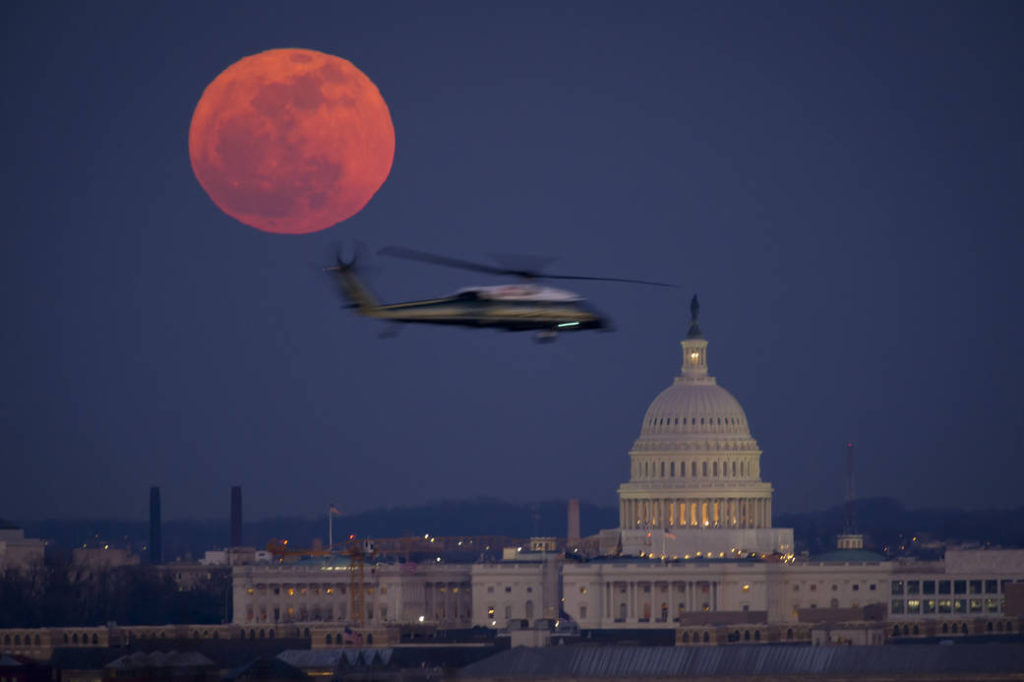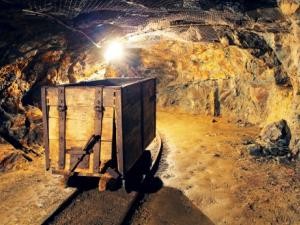
By Chris Flurry
President Donald Trump issued an Executive Order on Apr. 6, 2020, with potentially out-of-this-world implications.[1] The order encourages the U.S. and international communities – public and private – to support the exploration, recovery, and use of extraterrestrial resources.[2] While the order may seem to come at a surprising time,[3] it has reportedly been in the works for more than a year.[4]
The present administration has made no secret of its interest in outer space. In December 2017, the President issued a memorandum updating an Obama-era policy directive on the topic.[5] This memorandum replaced existing “far reaching exploration milestones” with an immediate call for the “return of humans to the Moon.”[6] Additionally, since February 2018, President Trump has shown interest in an expanded military role in space.[7] The U.S. Space Force became the newest branch of the U.S. military on Dec. 20, 2019, charged with the missions of “developing military space professionals” and “maturing the military doctrine for space power.”[8]
The new executive order appears commercial rather than military in nature. In the order, President Trump identifies commercial entities’ “[u]ncertainty regarding the right to recover and use space resources” as a limitation on existing policy.[9] Dr. Scott Pace, executive secretary of the National Space Council provided that the order, “establishes U.S. policy toward the recovery and use of space resources, such as water and certain minerals, in order to encourage the commercial development of space.”[10] This all of course begs the question: Can the President of the United States tell the rest of the world what to do with space?
The answer, as it happens, is a complicated one. The President notes in the order that authority is derived from the U.S. Constitution and statute.[11] Constitutionally, the President has broad powers in foreign affairs – though those powers are far from unlimited. For example, the President may enter into treaties, but only with the “advice and consent of the Senate” and two-thirds concurrence.[12] The Constitution also retained to Congress the power to “regulate commerce with foreign nations” and “define and punish . . . offenses against the laws of nations.”[13]
The statutory authority for the order is more straightforward. The U.S. Commercial Space Launch Competitiveness Act, signed into law in 2015, speaks specifically to commercial exploration and recovery of “space resources.”[14] By statute, these resources are defined as “abiotic resource[s] in situ in outer space,” expressly including water and minerals.[15] The Act charges the President, via appropriate agencies, to facilitate commercial exploration and recovery of space resources, discourage government barriers in the United States to this exploration and recovery, and “promote the right” of U.S. citizens to this exploration and recovery “in accordance with the international obligations of the United States and subject to authorization and continuing supervision by the Federal Government.”[16]
Presently, those “international obligations” primarily include a pair of documents, the 1967 “Outer Space Treaty”[17] and the 1979 “Moon Agreement.”[18] On the surface, the two may appear similar. Both the Outer Space Treaty and Moon Agreement specify that international law controls extraterrestrial affairs.[19] They also restrict military activity in space, particularly regarding nuclear weapons,[20] and establishing bases and conducting weapons testing.[21] Generally, both documents promote international “principle[s] of co-operation and mutual assistance” in space exploration and research.[22]
The two documents differ; however, in the limits a party may have in that exploration. While the Outer Space Treaty requires commercial activities be carried out under the authorization and supervision of a nation which is party to the treaty,[23] the Moon Agreement goes further. Under the Moon Agreement, the moon itself nor any of its resources may become property of any party – including commercial entities.[24] While the Moon Agreement does not expressly bar recovery of resources from the moon, it does specify these resources should be only be exploited under the supervision of an international regime, with the purpose of “rational management” and “equitable sharing” of those resources.[25]
Under the Moon Agreement, “the moon and its natural resources are the common resources of mankind.”[26] However, according to the President Trump’s Apr. 6, 2020, order, “the United States does not view [outer space] as a global commons.”[27] The order further notes that the United States is not amongst the eighteen parties to the Moon Agreement and charges the Secretary of State to “object to any attempt . . . to treat the Moon Agreement as reflecting or otherwise expressing customary international law.”[28] The executive order further specifies as a next step for the State, Commerce, and Transportation departments, NASA, and any other departments or agencies specified by the Secretary of State, to “take all appropriate actions to encourage international support” for recovering and using space resources.[29] Specifically, the order empowers the Secretary of State to seek bilateral and multilateral arrangements for extraterrestrial resource exploitation.[30]
Such “arrangements” need not, of course be treaties – keeping actions derived from the Executive Order outside those powers maintained by Congress by the Constitution. Certainly the President’s charge to departments and agencies to garner international support for moon resource recovery lies within the congressional mandate to “promote the rights of United States citizens” to mine the moon.[31] Further, as the United States is party to the 1967 Outer Space Treaty, but not the more limited 1979 Moon Agreement, promoting commercial exploration and exploitation of lunar resources arguably lies within those “international obligations” specified by statute.[32]
While the President’s Apr. 6, 2020, order has the potential for solar system-wide implications, its origins are likely much more domestic in nature. The President and his administration have sought to return to the moon by 2024;[33] however, members of Congress have sought longer timelines.[34] Garnering further commercial support for expeditions to the moon, and beyond, could be critical to astronauts venturing to the moon or mars on any timeline,[35] and conceptually commercial rights to those resources are an important part of the conversation. “Outer space is a legally and physically unique domain of human activity,” the Executive Order notes.[36] Without real international agreement on the best ways to explore, recover, use, and protect resources in outer space, the “Executive Order on Encouraging International Support for the Recovery and Use of Space Resources” at least moves the conversation forward on what a solution may look like. While an order pursuing commercial extraction of resources from the moon and asteroids may stand shockingly juxtaposed to international movements of the 20th Century to safeguard extraterrestrial resources, it is an affirmation of – rather than a departure from – U.S. space policy for much of the last decade.
[1] Michael Sheetz, Trump Wants More Countries to Join U.S. Policy Approach to Space Resources, Lunar Mining, CNBC (Apr. 6, 2020, 3:29 PM), https://www.cnbc.com/2020/04/06/trump-executive-order-on-us-space-resources-and-mining-policy.html.
[2] Exec. Order No. 13,914, 85 Fed. Reg. 20,381 (Apr. 10, 2020), https://www.govinfo.gov/content/pkg/FR-2020-04-10/pdf/2020-07800.pdf.
[3] The COVID-19 pandemic and its effects have required significant attention from global leaders in the spring of 2020. See generally COVID-19 Threatening Global Peace and Security, UN Chief Warns, UN News (Apr. 10, 2020), https://news.un.org/en/story/2020/04/1061502.
[4] See Sheetz, supra note 1.
[5] Memorandum on Reinvigorating America’s Future Space Exploration Program, 2017 Comp. Pres. Doc. 902 (Dec. 11, 2018), https://www.govinfo.gov/content/pkg/DCPD-201700902/pdf/DCPD-201700902.pdf.
[6] Id.
[7] Marina Koren, What Does Trump Mean by “Space Force?” The Atlantic (Mar. 13, 2018), https://www.theatlantic.com/science/archive/2018/03/trump-space-force-nasa/555560/.
[8] U.S. Space Force Fact Sheet, U.S. Space Force, https://www.spaceforce.mil/About-Us/Fact-Sheet (last visited Apr. 13, 2020).
[9] Exec. Order No. 13,914, supra note 2, at § 1.
[10] President Signs Executive Order on Space Resource Utilization, Off. of Space.Com (Apr. 6, 2020), https://www.space.commerce.gov/president-signs-executive-order-on-space-resource-utilization/.
[11] Exec. Order No. 13,914, supra note 2, at § 1.
[12] U.S. Const. art. II, § 2.
[13] U.S. Const. art. I, § 8.
[14] 51 U.S.C. §§ 51301-51303 (2018).
[15] 51 U.S.C. § 51301.
[16] 51 U.S.C. § 51302.
[17] Treaty on Principles Governing the Activities of States in the Exploration and Use of Outer Space, Including the Moon and Other Celestial Bodies, opened for signature Jan. 27, 1967, 610 U.N.T.S. 205 (entered into force Oct. 10, 1967) [hereinafter Outer Space Treaty], https://treaties.un.org/doc/Publication/UNTS/Volume%20610/volume-610-I-8843-English.pdf.
[18] Agreement Governing the Activities of States on the Moon and Other Celestial Bodies, opened for signature May 12, 1979, 1353 U.N.T.S. 3 (entered into force July 11, 1984) [hereinafter Moon Agreement], https://treaties.un.org/doc/Publication/UNTS/Volume%201363/volume-1363-I-23002-English.pdf.
[19] Outer Space Treaty, supra note 17, at 208; Moon Agreement, supra note 18, at 22.
[20] Outer Space Treaty, supra note 17, at 208; Moon Agreement, supra note 18, at 23.
[21] Outer Space Treaty, supra note 17, at 208; Moon Agreement, supra note 18, at 23.
[22] Outer Space Treaty, supra note 17, at 207; Moon Agreement, supra note 18, at 23.
[23] Outer Space Treaty, supra note 17, at 209.
[24] Moon Agreement, supra note 18, at 25.
[25] Id.
[26] Id.
[27] Exec. Order No. 13,914, supra note 2, at § 1.
[28] Id. at § 2.
[29] Id. at § 3.
[30] Id.
[31] 51 U.S.C. § 51302(a)(3).
[32] Id. § 51302(a)(2).
[33] NASA has expressed the 2024 timeline in much of its public-facing documents regarding the plan. See generally Apollo’s Legacy Is NASA’s Future, NASA, https://www.nasa.gov/specials/apollo50th/back.html (last visited Apr. 13, 2020) (“[E]xperiences and partnerships will enable NASA to go back to the Moon in 2024 – this time to stay — with the U.S. leading a coalition of nations and industry); What Is Artemis?, NASA (July 25, 2019),https://www.nasa.gov/what-is-artemis (“NASA is committed to landing American astronauts, including the first woman and the next man, on the Moon by 2024.”).
[34] Elizabeth Howell, Proposed House Bill Pushes NASA’s Crewed Landing Back to 2028, Space.Com (Jan. 28, 2020), https://www.space.com/house-bill-nasa-moon-landing-2028.html.
[35] Caroline Delbert, Trump Makes It Official: The U.S. Will Mine the Moon, Popular Mech. (Apr. 8, 2020) https://www.popularmechanics.com/space/a32082958/trump-moon-mining-asteroids/.
[36] Exec. Order No. 13,914, supra note 2, at § 1.

